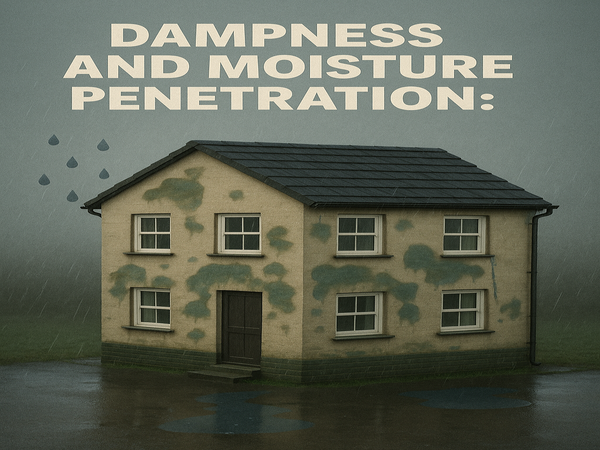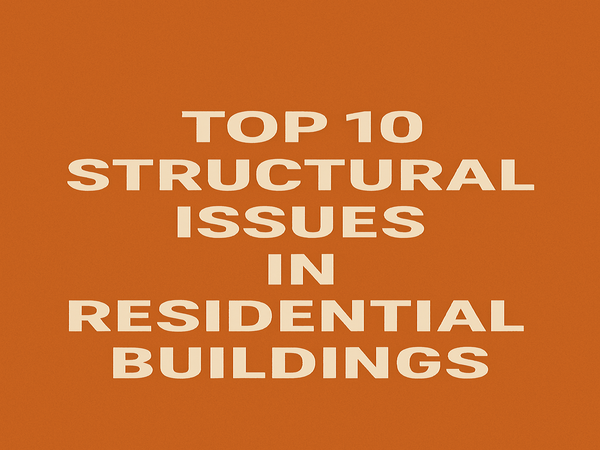Owning a home is a significant investment, and maintaining its structural integrity is crucial for safety, comfort, and long-term value. However, structural issues in residential buildings are more common than many realize, often developing slowly until they become serious and expensive problems. Understanding the most frequent structural issues, their warning signs, and causes can help homeowners take timely action and protect their property.
How to Identify Structural Issues in Residential Buildings
1. Foundation Problems:-
Foundation issues are among the most severe structural issues in residential buildings. They can be caused by soil movement, water damage, poor construction, or inadequate drainage. Warning signs include cracks in walls and floors, uneven flooring, and doors or windows that stick or don’t close properly. Left unaddressed, foundation problems can compromise the entire structure of a home.

2. Structural Movement:-
Structural movement encompasses subsidence, settlement, heave, and thermal or seasonal shifts. These movements manifest as cracks, bowing or leaning walls, and sticking doors or windows. Causes include poor soil conditions, inadequate foundations, and environmental changes. Early detection and professional assessment are essential to prevent further damage.
3. Roof Defects and Failures:-
The roof is a critical barrier against the elements, but it is also prone to structural issues. Common problems include sagging, leaks, missing or damaged shingles, and failed flashing. Causes range from poor installation and weather damage to aging materials. Roof defects can lead to water intrusion, mold, and even collapse if not addressed promptly.
4. Dampness and Moisture Penetration:-
Damp to external walls is a frequent issue, often resulting from failed damp proof courses (DPC), rising ground levels, or blocked gutters. Moisture can also infiltrate through roofs, windows, and basements. Persistent dampness leads to mold, wood rot, and weakened masonry, undermining a building’s structural integrity.

5. Cracks in Walls and Ceilings:-
Cracks are among the most visible structural issues in residential buildings. While some hairline cracks are cosmetic, larger or widening cracks can signal underlying structural movement, foundation settlement, or water damage. Monitoring crack patterns and consulting a structural engineer is crucial for accurate diagnosis.
6. Defective Gutters and Downpipes:-
Failed or blocked gutters and downpipes can cause rainwater to overflow, saturating walls and foundations. Over time, this leads to damp problems, masonry deterioration, and even foundation movement. Regular inspection and maintenance of rainwater goods are vital to prevent these issues.
7. Poor Structural Alterations:-
DIY renovations or unapproved structural changes such as removing load-bearing walls without proper reinforcement can seriously compromise a building’s stability. Always ensure that alterations are designed and supervised by qualified professionals to avoid introducing new structural issues in residential buildings.

8. Floor and Ceiling Problems:-
Uneven, sagging, or cracked floors and ceilings often indicate deeper structural problems, such as foundation movement, water damage, or pest infestation. These issues not only affect comfort and aesthetics but can also be signs of compromised load-bearing elements.
9. Condensation and Ventilation Issues:-
Poor ventilation leads to excess condensation, which can cause dampness, mold, and deterioration of building materials. Double-glazed windows with failed seals may also show condensation between panes. Ensuring proper airflow and maintaining seals helps prevent these moisture-related structural issues in residential buildings.
10. Eroded or Damaged Pointing:-
Pointing refers to the mortar between bricks or stones. Over time, weathering, poor-quality mixes, or water ingress can erode pointing, leaving masonry vulnerable to damp, frost damage, and structural instability. Timely repointing is essential for maintaining the structural envelope.
Preventive Tips for Homeowners:-
Preventing structural issues in residential buildings is often a matter of regular maintenance and early intervention. Here are some actionable tips:
- Maintain Proper Drainage: Ensure gutters and downpipes are clear and direct water away from the foundation7.
- Address Cracks Promptly: Monitor cracks and consult a professional if they widen or appear suddenly.
- Control Moisture: Fix leaks, improve ventilation, and use dehumidifiers in damp areas.
- Inspect After Severe Weather: Check for new damage after storms, floods, or earthquakes.
- Avoid DIY Structural Changes: Always seek professional advice before altering load-bearing walls or supports.
- Schedule Regular Professional Inspections: Especially for older homes or after major renovations.
When to Seek Professional Help:-
If you observe any of the following, contact a structural engineer immediately:
- Large or rapidly growing cracks in walls or foundations
- Noticeable sagging or movement in floors, ceilings, or roofs
- Persistent dampness, mold, or water intrusion
- Doors and windows that suddenly become difficult to operate
- Bowing or leaning walls
A timely professional assessment can prevent minor issues from becoming major structural failures.
Sample Structural Inspection Checklist:-
Here’s a condensed version of a professional inspection checklist for residential buildings:
| Area | What to Check For |
|---|---|
| Foundation | Cracks, settlement, water pooling |
| Exterior Walls | Cracks, bulges, dampness |
| Roof | Leaks, sagging, damaged shingles |
| Gutters/Downpipes | Blockages, secure attachment |
| Floors/Ceilings | Sagging, unevenness, cracks |
| Windows/Doors | Sticking, gaps, misalignment |
| Attic/Basement | Moisture, insulation, pests |
| Load-Bearing Elements | Visible damage, corrosion, movement |
| Stairs/Decks | Stability, rot, loose fittings |
FAQs:-
Q1: What are the most serious structural issues in residential buildings?
A: Foundation problems and significant structural movement are the most serious, as they can compromise the entire building.
Q2: How can I spot early signs of structural issues?
A: Look for cracks in walls or floors, uneven surfaces, sticking doors/windows, damp patches, and roof leaks.
Q3: Are all cracks in walls a sign of structural issues?
A: Not all cracks are structural, but large, widening, or diagonal cracks should be assessed by a professional.
Q4: Can poor drainage cause structural problems?
A: Yes, inadequate drainage can lead to water accumulation around the foundation, causing settlement and dampness.
Q5: What should I do if I suspect a structural issue?
A: Contact a qualified structural engineer for a thorough inspection and recommendations for repair.
Conclusion:-
Structural issues in residential buildings can develop from a range of causes, including poor construction, environmental factors, and neglect. Regular inspections, prompt repairs, and professional guidance are the best ways to safeguard your home’s integrity and value. If you notice any warning signs, don’t delay early intervention can save you from costly damage and ensure your home remains safe for years to come.
Read More On:-
For more information about engineering, architecture, and the building & construction sector, go through the posts related to the same topic on the Specuwin Blog Page.
Find out more accurately what we are going to take off in the course of applying leading new technologies and urban design at Specuwin.
